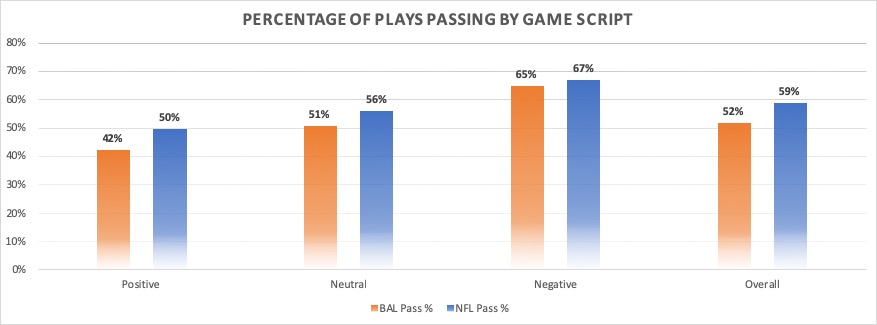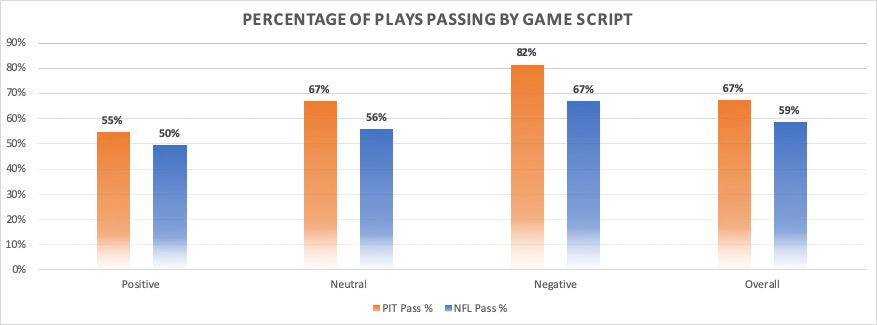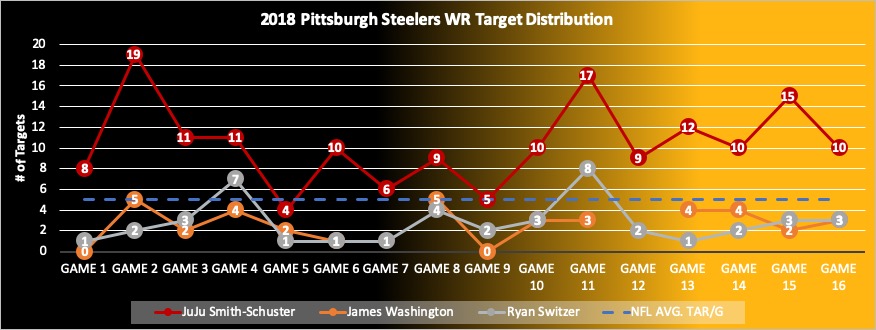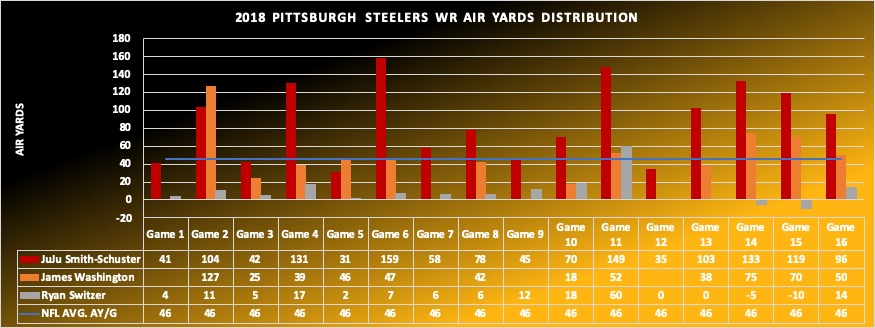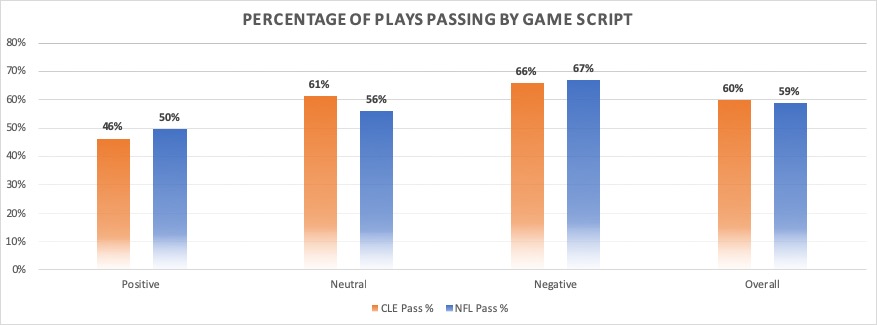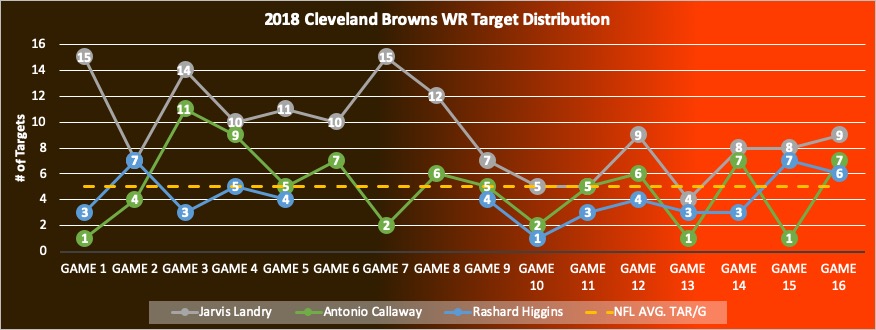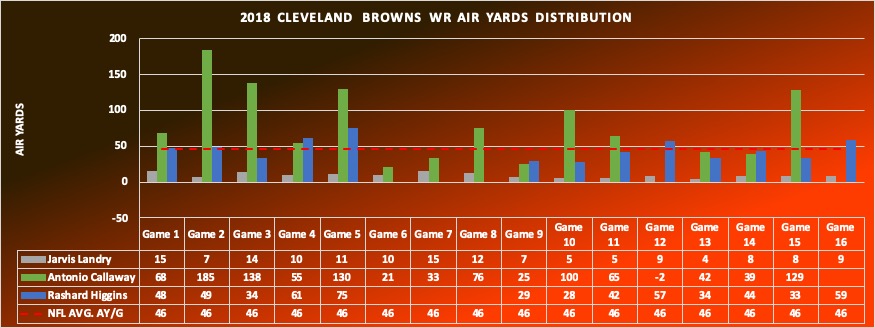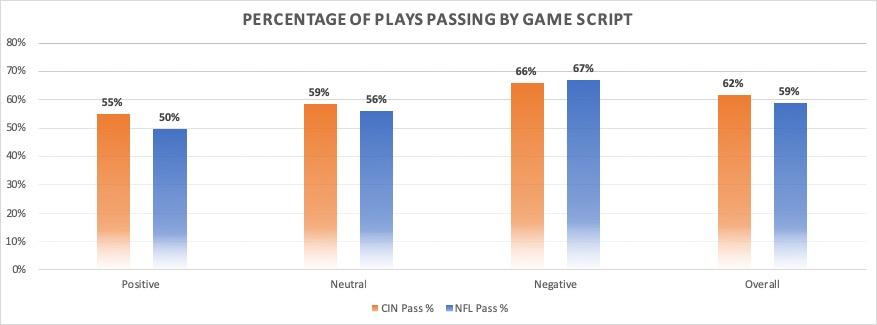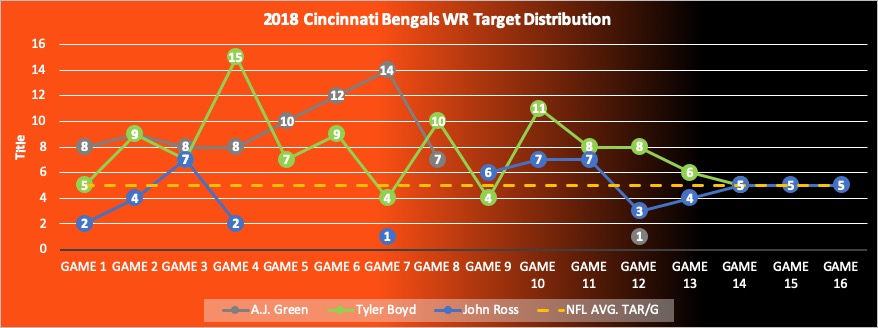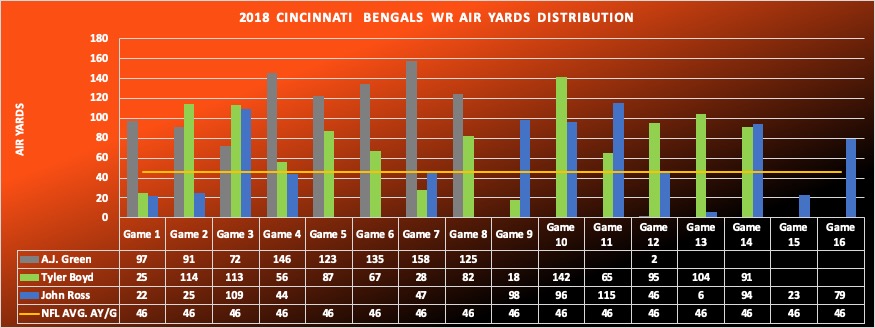Baltimore Ravens
The Baltimore Ravens ran by far the most plays in the NFL last year with 1135. The next closest team was the New England Patriots who ran 62 fewer plays.
Unfortunately for owners of Ravens wide receivers last season, Baltimore finished in the bottom half in passing plays run (588) and bottom three in the percentage of passing plays (52%). Baltimore did play with more than a single score lead for most of their offensive plays, which typically causes teams to run the ball and the clock simultaneously. However, even when trailing by more than one score, the Ravens still threw passes on a lower percentage than most teams in the league.
Baltimore invested heavily in the wide receiver position during this year’s draft. After letting their top receiver in 2018, John Brown, leave in free agency. However Brown only vacates 97 targets, which was the 26th most targets for a wide receiver that was targeted at least 24 times.
There should be an increase in passing volume this season as new Offensive Coordinator Greg Roman helps to take the reigns off of second-year quarterback Lamar Jackson. Jackson will need to improve his efficiency to help his rookie receivers, especially when throwing from a clean pocket. Jackson’s adjusted completion percentage from a clean pocket is just 67% according to Pro Football Focus. That percentage was last in the league for quarterbacks that took at least 20% of the offensive snaps last year.
Willie Snead was a consistent part of the offense last season until Jackson took over. Snead averaged just as many targets per game as their number one receiver John Brown. Snead was near league average in yards per route run (Y/RR) averaging 1.49 yards per route. Snead doesn’t stand out in any other receiving metric. He is a solid receiver that will look to top 100 targets with increased passing volume and less established rookies to compete with.
Pittsburgh Steelers
The Steelers had the most passing volume of any team in the NFL last season. They threw the ball a total of 713 times which was 20 more than the second-place Green Bay Packers.
While they had the most passing plays, they were second in the percentage of their total plays that were executed through the air. The Steelers threw the ball on 67% of their offensive plays. Within that 67%, Pittsburgh aired it out an astounding 82% of the time when playing in a negative game script (trailing by more than one score). That’s 15% more than league average and an indicator to keep an eye on those vegas lines. If Pittsburgh is not favored, get all the pass catchers from the Steelers in your lineup!
In the vacuum that former number one receiver Antonio Brown left behind is a total of 167 targets and 26% target share in the most voluminous passing offense in football. This lines up well for former WR2 and current WR1 JuJu Smith-Schuster. Smith-Schuster had nearly the same volume as AB last season with 166 targets compared to Brown’s 168. The only concern (and it’s a big one) is how JuJu will hold up playing a totally different role. As Matt Harmon elaborated on in his Reception Perception comparison, Smith-Schuster ran the vast majority of his routes against zone defenses in the slot or flanker positions. In this area, he is a mismatch against linebackers and safeties that do not press him to disrupt his timing. He has much less experience playing the outside receiver position and against press-man coverage, which Antonio Brown faced nearly 50% of the time. Look for the Steelers to try to keep JuJu in the slot and flanker position and keep new acquisition Donte Moncrief and second-year receiver James Washington outside.
Washington has played well this preseason and has shown that he can be an effective part of the offense. However, Washington was very inefficient in 2018 with on .57 Y/RR. Although Washington became more involved in the offense the last four games of the year when considering air yards, he was not trusted from the opponents 10-yard line and in. Washington receiver no targets within that area of the field. This is an area that new arrival Moncrief has excelled in his career. Since he entered the league Moncrief has earned 21 targets within the 10 and converted 10 of those targets for touchdowns. Washington has the talent upside, but Moncrief has the touchdown upside this season. Who you choose may have more to do with the format you are playing than anything else.
Cleveland Browns
Cleveland was a top ten offense in passing volume in 2018. They threw a total of 612 times.
The good news for Cleveland fans is that the Browns were competitive after Freddie Kitchens took over play-calling duties starting in game nine. However, fantasy owners with stock in Cleveland receivers need to note that because Cleveland was more competitive, the played in more positive game scripts. This means the passing volume in games 9 through 16 fell from 340 passes to 272. While the passing percentage stayed right around 60% from the first eight games, it was 60% of a smaller pie later in the season.
The passing games stayed fairly consistent and did not have an effect on most of the Browns receiving core. That is unless your name is Jarvis Landry. In games 1-8, Landry averaged 11.75 targets per game. When Kitchens took over and the team became competitive, they had to rely less on their number one receiver and his volume dropped to 6.88 targets per game.
It is also worth noting that (currently suspended receiver) Antonio Callaway had his biggest games prior to Kitchens taking over. While his average targets per game only dropped by one, his air yards per game dropped by 19 air yards per game. With Callaway coming into camp out of shape and receiving a suspension from the league, and having to compete with a more talented 2019 roster (see: Odell Beckham Jr.) his star is fading fast in Cleveland.
Cincinnati Bengals
The 2018 Bengals offense ran at a fairly slow pace. They were 22nd in the league in the number of offensive plays run. If their offense can run more plays per game with new head coach Zac Taylor, there is some opportunity to look into.
The Bengals ran 58.63 plays per game in 2018. In Taylor’s previous tenure as an offensive coordinator for the last five games with the 2015 Miami Dolphins, his team ran 61.60 plays per game. He was also on the offensive coaching staff for the 2017 and 2018 Rams that ran 62.50 and 66.25 plays per game respectively. Taylor has been a part of teams that play more uptempo and we hope to see that trend transition to his first head coaching position.
Tyler Boyd averaged a solid 7.71 targets per game last season and that total did not waver much in either direction with number one receiver A.J. Green out of the lineup. With Green hurt once again for the beginning of the season, Boyd should expect to be treated as the Bengals number one receiver by defenses.
When looking at air yards, Boyd was a fairly consistent player within the Cincinnati offense averaging 77.64 air yards per game. Boyd was also very efficient in averaging 2.04 Y/RR boosted by his 5.6 YAC/REC. Boyd is a screaming value at an ADP according to FantasyPros of WR 23 (55th overall) With the possible increase in passing volume from Zac Taylor’s offense, Boyd could see an increase in opportunity and should be a player you target.
Statistics in the article provided by airyards.com, pff.com
(Photo by Ian Johnson/Icon Sportswire)


